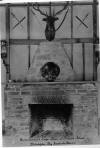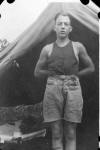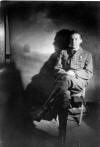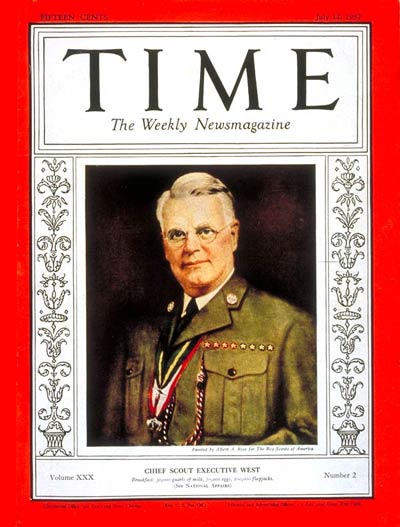Boy Scouts of America, Order of the Arrow & Unami Lodge One
A History, My Legacy
Mark A. Lewis
In the city of Philadelphia, Pennsylvania on the 15th August 1905 were born twin boys to Joseph Nathaniel Pattison II and his wife Eliza Belle. The boys, Joseph III and William were to play a role at the start of a new movement in the United States known as the Boy Scouts of America. However, this was not until 1916, because prior to 1910 Scouting was an experiment with 20 boys and a camping trip for nine days of August, 1907 at Brownsea Island, near Poole in Dorest, England.
The camp was a huge success and proved to its organizer, Robert Baden-Powell that his training and methods appealed to young people and truly worked.
Today there are more than 28 million Scouts, young people and adults, male and female, in 160 countries and territories. About 300 million people have been Scouts, including prominent people in every field. Pretty impressive since, initially, it was only an experiment.
Lord Robert Baden-Powell of Gilwell (1857-1941) was a decorated soldier, talented artist, actor and free-thinker. Best known during his military career for his spirited defense of the small South African township of Mafeking during the Boer War, he was soon to be propelled to extraordinary fame as the Founder of Scouting.
Robert Baden-Powell was born 22 February 1857. He was, 50 years old when the Brownsea camp took place. His many experiences as a boy and as a soldier played a part in the formulation of this training methods.
As a youngster - one of ten children (six brothers) - he spent his holidays camping, hiking and sailing.
Tent pitching, map and compass use, and wood-fire cooking were but a few of the skills he acquired. Near his school at Charterhouse, England, he used to sneak into the forest, which was off-limits; here he learned how to hide his tracks, climb trees and "freeze" to escape attention if any of the school masters entered the woods.
In 1876 he went to India as a young army officer and specialized in Scouting, map-making and reporting. His success soon led to his training other soldiers for the work. B-P's methods were unorthodox for those days; small units or patrols working together under one leader, with special recognition for those who did well. For proficiency, B-P awarded his trainees badges resembling the traditional design of the north compass point. Today's universal Scout badge is very similar.
Later he was stationed in the Balkans, South Africa and Malta. He returned to Africa to help defend Mafeking during its 217-day siege at the start of the South African war. It provided crucial tests for B-P's Scouting skills. The courage and resourcefulness shown by the boys in the corps of messengers at Mafeking made a lasting impression on him. In turn, his deeds made a lasting impression in England.
Returning home he found that he had become a national hero. He also found that the small handbook he had written for soldiers was being used to teach observation and woodcraft to members of Boys' Clubs and Boys' Brigade. B-P decided to rewrite the book especially for boys. The 1907 camp on Brownsea Island was to test his ideas in practice.
In January 1908, he published the first "Scouting for Boys", a book issued in fortnightly parts at four pence each. It was an immediate success. Baden-Powell had only intended to provide a method of training boys, something that existing youth organizations such as the Boys' Brigade and Y.M.C.A. could adopt. To his surprise, youngsters started to organize themselves into what was destined to become - and is today - the world's largest voluntary youth movement.
The success of "Scouting for Boys" produced a Movement that quickly – automatically it seemed – adopted the name of The Boy Scouts and necessitated the establishment of an office to administer it.
By 1909 the Movement had taken firm root. "Scouting for Boys" had been translated into five languages. A Scout rally in London attracted more that 11,000 Scouts. As a result of B-P taking a holiday in South America, Chile was one of the first countries outside Britain to begin Scouting. In 1910 he visited Canada and the United States where it had already started.
The coming of the war in 1914 could have brought about the collapse of the Movement, but the training provided through the patrol system proved its worth. Patrol leaders took over when adult leaders volunteered for active service. Scouts contributed to the war effort in many ways; most notable perhaps were the Sea Scouts who took the place of regular coast-guardsmen, thus freeing them for service afloat.
The first World jamboree took place in 1920 with 8,000 participants, and proved that young people of many nations could come together to share common interests and ideals. Since that first World Jamboree at Olympia in London, there have been 17 others at different locations.
During the Jamboree the first International Scout Conference was held with 33 national Scout organizations represented. The Boy Scouts International Bureau was founded in London in 1920.
In 1922 the first International Committee was elected at the 2nd International Conference (Paris), where 31 national Scout organizations were represented. World membership was just over 1 million.
Early Scouts
Scouting began as a program for boys 11 to 18 years of age. Yet almost immediately, there were demands by others to participate. The Girl Guides program was started in 1910 by B-P. His wife Olave, whom he married in 1912, became Chief Guide.
A Wolf Cub section was formed for younger boys. It used Kipling's "Jungle Book", to provide an imaginative symbolic background for activities. For older boys, a Rover Scout branch was formed.
The names and characteristics of program vary from country to country: Cub Scouts, Beavers, Rovers, Explorers, Senior Scouts and many more. In some countries boys can start when they are six years old. Some programs are open to girls and boys.
World Wars
Between the two world wars Scouting continued to flourish in all parts of the world - except in totalitarian countries where it was banned. Scouting is essentially democratic and voluntary.
The war came in 1939, Scouts again carried on under their patrol leaders; they undertook many national service tasks – messengers, fire watchers, stretcher bearers, salvage collectors and so on. In occupied countries, Scouting continued in secret with Scouts playing important roles in the resistance and underground movements. After the liberation, it was found that the numbers of Scouts in some occupied countries had, in fact, increased.
The '60s, '70s and '80s
Many countries gained their independence during these years. Scouting in developing countries gradually evolved to be a youth program, which was designed by Scout leaders in each country to better meet the needs of their communities.
Scouts, particularly in developing countries, became more involved with issues such as child health, low-cost housing, literacy, food production and agriculture, job skills training, etc.
Drug abuse prevention, life skills training, integration of the handicapped, environmental conservation and education, and peace education became issues of concern to Scouts around the world.
Post Communistic Era
In the 1990s Scouting has been reborn in every country where it existed prior to World War II, and it has started throughout the newly independent countries of the Commonwealth of Independent States (formerly the USSR). Since 1993, 35 countries have joined, or rejoined, the World Organization of the Scout Movement.
What started as a small camp on Brownsea Island is today a growing Movement with members in nearly every country in the world. What started as an outdoor camp to teach skills is today a program that is used successfully in such diverse settings as developing countries and metropolitan inner-cities.
The Order of the Arrow - Society of Honor Campers
Unami Lodge, and the Order, was founded at Treasure Island Scout Camp in the summer of 1915 by E.Urner Goodman, the Camp Director, and Carroll A. Edson, the Assistant Camp Director, to perpetuate camp traditions and ideals from summer to summer. The organization was to be based on Leni Lenape Indian traditions.
Preliminary research on the Delaware Tribes and language was done prior to the start of summer camp by "Shorty" Rolston, a Philadelphia scouter.
At Treasure Island, a natural ravine near the south tip of the island is selected as the new Order's ceremonial ground. Preparatory work in getting this site ready for use is done by Goodman and Harry Yoder of Philadelphia Troop 3. Yoder is soon appointed as the Order's first guide and guardian. A totem decorated with a tortoise was erected at the ceremonial ground. This totem was chosen because it was used by Chingachgook and Uncas (familiar from James Fenimore Cooper's Leatherstocking Tale and our own Legend). The tortoise is also the symbol of one of the three major Delaware clans (along with the Turkey and Wolf).
The original robes are made by a local farmer's wife and after dark in mid-July the first ceremony is performed. Two scouts (Robert Craig and Gilpin Allen) are led silently by Guide Yoder in single file from the flag pole at the parade grounds to the ceremonial grounds and a three step open ritual begins before the assembled camp. Each of the three parts of the ritual represents a different ideal of the new society called Wimachtendienk W.W.: Brotherhood, Cheerfulness and Service. The first ordeal is spent performing service for the local farmers on the mainland in silence and without food. At the end of the first summer 25 members (including Goodman and Edson) are wearing the black sashes with white bars of the Order.
During the first year Dr. William Hinkle plans the ritual for the second degree, later to be called Brotherhood in the 1930s. This gives rise to the third degree, later to be called Vigil. The first vigil honor goes to E.Urner Goodman followed that winter by Carroll Edson. Returning from historic Devil's Tea Table where his vigil was kept, Goodman receives only his Indian name, Nuwingi (or willing), as the triangle representing vigil is not yet used.
Later that first year the arrow and turtle are formally adopted as symbols of the Lodge. George Chapman is elected as the first Lodge chief.
A second Philadelphia Lodge (Unalachtigo, 8) based on the Turkey Clan of the Delawares is soon established at Philadelphia Council's Camp Biddle. This is merged into Unami Lodge with the closing of this camp.
Unami Lodge hosts Grand (National) Lodge meetings in 1921, 1925, 1929 and 1936. At the 1921 meeting E. Urner Goodman is elected the first Grand Chieftan.
The Lodge House on Treasure Island is begun in 1919 and completed in 1921 with funds and labor supplied by the Lodge. A dining addition is added in 1937 and a sleeping addition and bathroom are added in the 1980s. The original structure is much the same today as in was in the 1920s.
Hart Scout Reservation opens in 1930 and in 1935 Unami Lodge opens a renovated stone farm house on Swamp Creek Road as its Lodge House at this camp.
In 1935 Unami Lodge changes its name to Unami Tribe, likely due to religious implications of the word "Lodge." This change lasts about one year,when the name reverts back to Unami Lodge. The Lodge celebrates its fiftieth anniversary in 1965 by hosting the Area 3A Conclave with E. Urner Goodman in attendance. Over 1000 brothers attend the annual banquet that year.
The 1980s mark the end of an era. Dr. E. Urner Goodman passes away in March 1980 in Clay County, Florida at Penney Farms, retirement community founded by J.C. Penney in 1925 followed in October1986 by Carroll A. Edson in Sharon, Windsor, Vermont.
In January 1996 Unami Lodge undergoes its second merger, combining with Delmont Lodge #43, creating a strong, cohesive unit. Delmont Lodge dates back to July 9, 1929 when Jack Foster, Activities Director at Camp Delmont and Henry Faucett with the aid of Russell Mott of Minsi Lodge 5 charter Delmont Lodge 43. Earlier that summer both Foster and Faucett take their ordeal at Treasure Island Scout Camp. 61 members are inducted into Delmont Lodge the summer of 1929. Delmont holds its first Brotherhood ceremony on April 26, 1930 at the Norristown Scout Cabin. The ceremony is similar to that held today except it included a "bloodletting." Costumes are borrowed from Unami Lodge. Jack Foster becomes Delmont's first vigil member on September 12, 1931 at the National meeting at Lake George, New York.
Today Unami Lodge #1 serves the five great scout camps of The Cradle of Liberty Council: Treasure Island (founded 1913), Resica Falls (founded 1956), and the three camps of Musser Scout Reservation, Camp Delmont (founded 1916), Camp Hart (founded 1930) and Camp Garrison (opening in 1999).
As young men growing up in Philadelphia, Joseph N. Pattison III and his twin brother William S. Pattison (my Grandfather) were quite active in the Boy Scouts of America. As members of Troop 3 in Philadelphia, they were the first double Eagle Scouts in the movement, earning twice the required merit badges. They earned the Eagle Scout award on September 29, 1921 (Joe) and (Bill) October 31, 1921; with a Court of Honor Ceremony for the presentation on November 10, 1921.
Around 1920 the Pattison twins were inducted into the Order of the Arrow, Unami Lodge One, later were bestowed Vigil Honor in 1928 (Joe) and 1930 (Bill). They served on the staff of Treasure Island Scout Camp, Leaders of Troop 217 at Holy Trinity Presbyterian Church and as Unami Lodge Chiefs. Joseph N. Pattison III went on to serve as Grand Lodge Treasurer for the Order of the Arrow Unami Lodge One for a number of years. This, and his dedicated service to Scouting and the Lodge led to being awarded the Distinguished Service Award. He was inducted with the first group in 1940 which included E. Urner Goodman, Carroll Edson, James West and 7 others.
Unami Lodge One Chiefs
Joseph N. Pattison III 1926 William S. Pattison 1927
The Distinguished Service Award History
First awarded in 1940. There were 11 recipients, they were: Thomas G. Cairns, Carroll A. Edson, E. Urner Goodman, Harvey A. Gordon, Robert S. Henderson, Dr. William M. Hinkle, H. Lloyd Nelson, Alfred C. Nichols Jr., Joseph N. Pattison III, William A. Stumpp, Dr. James E. West
The Distinguished Service Award (DSA) is a service recognition award for those who have rendered distinguished and outstanding service to the OA on a sectional, regional, or national basis over a period of years.
The first awards were presented at Camp Twin Echo, Pennsylvania, to E. Urner Goodman, Carroll A. Edson, and eight others at the 1940 national meeting. Between 1940 and the first national conference in 1948, the award was presented at national meetings as deserving individuals were found. Thereafter, the award presentation became a traditional part of the pageantry and ceremony of the national conference.
Since the time of the first awards in 1940, fewer than 900 Distinguished Service Awards have been presented. This alone is a testament to its high standard of excellence. The award is a sterling silver arrowhead, bearing an arrow pointing upward and to the wearer's right, suspended from a white neck-ribbon upon which are embroidered red arrows (the first awards were suspended from a forest green ribbon – the current ribbon has been in use since the 1960s). A white square knot embroidered upon red cloth is available for uniform wear, and a miniature silver arrowhead lapel pin is available for civilian wear.
Presentation of the award is limited. Arrowmen whose service records are the most outstanding and extend farthest beyond others are usually selected. Nominations are open to both youth and adult Arrowmen.
Some Early (1915) Treasure Island Pictures, 1917 Troop 3, Alfred Nichols and TI Staff 1925
A full photo essay from 1917 to 1930 based upon my Grandfather's pictures (taken and developed by himself) will be added soon to the Photo History Page.














